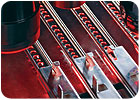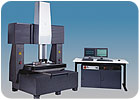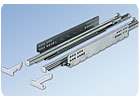
Werth Inspector FQ CMMs are used by furniture hardware manufacturer Hettich for in-process measuring. Source: Werth Messtechnik GmbH
Safeguarding a reputation for high-quality products is inconceivable without the appropriate measurement systems, even at in-process stages. Measurement at the machine tool workstation, for many companies, primarily means manual measurement with such instruments as calipers, micrometers or indicators. A qualified worker knows how to use these, and the measurement results are usually satisfactory.
However, the results depend on the worker, so they may allow undesirable leeway in interpretation, which cannot be documented. The results also are seldom integrated into a computer-aided quality (CAQ) system. Rather, they are written down and these valuable pieces of data disappear into a file cabinet. This entire process can be done more precisely, faster and, above all, in a way that supports evaluation.
Furniture hardware manufacturer Hettich (Kirchlengern, Germany) provides an example of how this can be achieved. There, the manual measurement tools that used to be standard for worker in-process inspection have been replaced with 3-D coordinate measuring machines (CMMs) with multisensor technology.
Improving Inspection
Several Inspector FQ 3-D computer numerical control (CNC) CMMs from Werth Messtechnik (Giessen, Germany) have replaced manual workstations for in-process inspection. In parallel, a measurement technology discipline has been implemented in the company’s quality assurance department to provide a program structure for 3-D CMMs.The software program for the in-process measuring machines and the master programs are specified by this area. The quality assurance department trains the in-process machine operators and converts the master final inspection programs into variations for the in-process stages. Currently there are about 1,600 programs on each measuring machine. To handle large quantity throughput, these programs are duplicated on several measuring machines on the in-process shop floor area. This effectively safeguards the high quality standards set by Hettich.
The Kirchlengern facility uses several profiling systems on which components are machined for drawer slides for kitchen, bath and office furniture. Precision is required in this process so that a drawer opens and closes smoothly. Therefore, product specifications must be kept in mind and monitored during the production process.
Faster measurement was foremost in the thoughts of the Hettich management, which led to purchasing Werth Inspector FQ CMMs. The CMMs use a combination of image processing sensors and tactile probes along with a quick linear way machine designed to provide fast and flexible multisensor CMM technology.
The Werth Inspector FQ CMMs have wear-free linear direct drives that move with high positioning speeds. Additionally, any feature that can be measured optically also can be measured faster and with more consistent accuracy than with touch probes. For Hettich, the ability to measure faster means the ability to greatly increase throughput.

The Werth Inspector FQ multisensor CMM has helped Hettich cut costs and improve part quality. Source: Werth Messtechnik GmbH
Proof is in the Comparison
This ability is illustrated by a comparison of inspection methods on a real part at Hettich, known as the positioning hook. This is a stamped sheet-metal part with several cutouts and holes. The hook heights were previously inspected with a check gage. Other relevant features, such as the hook position, were measured with an indicator or caliper. Manual measuring machines also were previously available for capturing the relevant dimensions.With conventional tactile coordinate measurement technology, each part took 17 minutes. Experiments and test measurements with conventional multisensor technology resulted in 10 minutes for one measurement cycle. The Werth Inspector FQ, however, cut this time in half with a cycle time around 5 minutes.
Furthermore, Werth’s “OnTheFly” process for rapid measurement with image processing can reduce optical measurement time by a factor of 10. The “OnTheFly” measurement takes place during continuous movement, preventing motion blur and making the time required for start-stop operation no longer needed. At Hettich, the measurement cycle per component was cut in half, resulting in a total measurement time of about 2.5 minutes.
Combining Sensor Technology
With optical and tactile sensors, the measurement sequence can be completely accomplished in one setup, independent of operator influence. Lengths and widths, hole positions, cutout patterns, and twisting and bending are measured. Sixty percent of the positioning hook’s features are measured optically by the image-processing sensor.The camera electronics in the image-processing sensor convert optical signals that enter through the lens into a digital image via gray scale technology. This image also is visible to the worker on a display monitor. Appropriate software ensures that dimensions and tolerances-for the tactile sensor, as well-can be displayed and documented.
Despite the draw of noncontact measurement with optical sensors, tactile sensors cannot be completely discarded. There are geometries that optics cannot measure, such as undercuts. Features that are not visible to the image-processing sensor can be measured in the same setup on a multisensor machine by using a contact measurement system. Three-dimensional contours and surfaces also can be scanned. This also applies to level sections and prescribed paths, with as many measurement points as desired.
In the case of the positioning hook, the remaining 40% of the measurement tasks require the probe. The ratio is dramatically inverted for the time needed for the entire measurement cycle. The probe takes about 70% of the total cycle time for its 40% share. In this regard, the use of optics has the advantage, but in the end, it is the combination of optics and probe, as well as the high machine dynamics, that makes the Inspector measuring machines efficient. In the final balance, the measurement costs per part are reduced by more than half.

Hettich’s metal components are measured with the Werth Inspector FQ’s optical and touch probe sensors. Source: Werth Messtechnik GmbH
A Higher Level of Quality
The automated, fast measurement in Kirchlengern has one goal, namely to improve the quality of the final products even further. The operator places the part on the holding fixture of the CMM, and then starts the measurement program. The rest happens automatically, and the operator can tell immediately from the inspection report whether the production machine needs to be adjusted, what parameters need adjusting and by exactly how much.Multisensor CMMs allow even complex parts to be measured in one step because all sensors work in the same coordinate system. Existing measurement programs can be easily modified for new part revisions. Setup times and inspection costs per part are greatly reduced. Because, in principle, all parts can be measured on the same machine, each part does not need special measuring fixtures or gages. Calibration and master parts no longer need to be manufactured.
The administrative costs associated with calibration and maintenance also are eliminated. The traceability of the measurement results to national standards is implicitly provided.
Hettich has found that an investment in the use of multisensor CMM technology for a large variety of parts is quickly cost justified. The intangible value of quality, customer perception and the resulting repetitive orders gained through improved quality control is more difficult to calculate.
- Werth Messtechnik GmbH
(860) 399-2445
www.werthinc.com